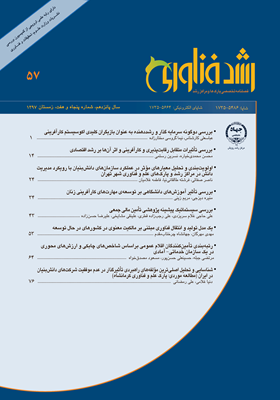یک مدل تولید و انتقال فناوري مبتنی بر مالکیت معنوی در کشورهای در حال توسعه
محورهای موضوعی : Technology Transfer and Commercialization of Researchesمهدی مهرگان 1 , جهانشاه چرختاب مقدم 2
1 - دانشگاه علوم تحقیقات
2 - دانشگاه عالی دفاع ملی
کلید واژه: مالکیت معنوی انتقال فناوری تولید فناوری مدل انتقال روش دلفی,
چکیده مقاله :
توانمندسازی هر کشور در حوزههای علمی و فناوری نیازمند توجه به دانش بومی و استفاده از تجربیات کشورهای توسعهیافته در این حوزه است. لذا باید تولید و انتقال فناوری در کنار یکدیگر مورد توجه قرار گیرند تا ضمن جلوگیری از به هدر رفتن زمان و انرژی، زمینههای بومیسازی علمی نیز فراهم گردد. این مهم زمانی حاصل میشود که مالکیت معنوی در انتقال فناوری، به مثابه یک نیروی حمایتی از صاحب فناوری نیز مورد توجه قرار گیرد. به دلیل این اهمیت، در این مقاله با ارائه مدلی بومی، مسیری در تولید فناوری داخلی در کنار انتقال فناوری که مورد مشورت نخبگان قرار گرفته است را ترسیم میکنیم. به منظور دستیابی به این مدل، ابتدا به روش دلفی، مدل اولیه به وسیله جمعی از متخصصین و خبرگان مورد بررسی قرار گرفت. سپس مدل نهایی، جهت سنجش فاکتورهای تأثیرگذار بر مدل به روش میدانی و با ابزار پرسشنامه تحلیل گردید. مدل حاصل، فرایند تولید و انتقال فناوری از مرحله قانونگذاری تا عرضه محصول حاصل از فناوری را تبیین میکند. نتایج نشان میدهد گسترش زیرساختها و تخصیص بودجه، ایجاد کارگروههای مجزا برای شاخههای مختلف تولید اثر، ارائه تفسیرهای بروز از مبانی اسلامی در ارتباط با مالکیت معنوی، اولویتدهی به پژوهشهای کاربردی، ایجاد و حمایت از پارکهای علم و فناوری، ایجاد ساختار اطلاعاتی استفاده از دانش جدید و جذب نوآوری و قابلیت انطباق، جهانیسازی و ورود به رقابتهای جهانی، دفاع از حقوق مالک در مجامع داخلی و بینالمللی و معرفی اولویتهای سرمایهگذاری از بیشترین اهمیت در مدل برخوردارند.
The empowerment of each country in the fields of science and technology requires attention to indigenous knowledge and, of course, the use of the experiences of developed countries in these areas. Therefore, production and technology transfer should be considered together in order to prevent the waste of time and energy, also provide scientific grounds for localization. This is important when the intellectual property of technology transfer, as a supportive power of the technology owner, is also taken into consideration. Because of its importance, in this paper, by presenting a model, we draw a proper path in the production of domestic technology along with the transfer of technology that has been consulted by the elite. The resulting model explains the process of manufacturing and transferring technology from the legislative stage to the product delivery of the technology. In this model four phases of infrastructure, creation, supportive and final are considered. In the infrastructure phase, the legal dimensions of intellectual property laws as well as methods for creating the right conditions for the transfer and production of technology in the Government, Parliament and the Guardian Council are examined. In the phase of creation, the responsibilities assigned to the relevant ministries, as well as the improvement of the power of science and technology parks along with the appropriate direction for them. The supportive phase is a guarantee of the implementation of the law and, in addition, it has a supportive role in creating a suitable platform for technology vendors. Finally, the process of fusing and commercializing technology in the final phase is examined.
